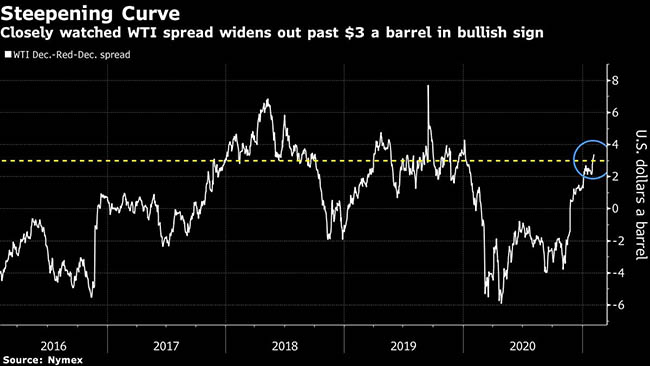Bloomberg News
Oil Extends Weekly Gain; Brent Pushes Toward $60 a Barrel

[Stay on top of transportation news: Get TTNews in your inbox.]
Oil set a fresh one-year high in New York with continued producer supply curbs helping spur strength everywhere from physical markets to the futures curve.
Futures gained 1.1% in New York on Feb. 5 to the highest since late January, while Brent crude remained just under $60 a barrel in London. The number of vessels sailing toward China jumped to a six-month high on Feb. 5, suggesting the world’s largest importer may be piling back into the oil market. Meanwhile, crude stockpiles tied to oil futures in China fell to the lowest since June 2020, according to data analytics company OilX, the latest sign of ebbing inventories.
Crude was buoyed this week by a pledge from the Organization of Petroleum Exporting Countries and its allies to keep draining a virus-driven surplus. Expectations of a global economic recovery this year are also raising forecasts for stronger oil demand, even though lockdown measure are restricting mobility in the meantime. At the same time, more money is flowing into the space with investor holdings of West Texas Intermediate futures soaring to the highest since 2018.

“There’s going to be bumps in the road, but we know the final outcome now, which is that we’re heading back toward a lot more normal,” said Vikas Dwivedi, a global energy strategist for Macquarie Group in Houston. “Demand bottomed, supply has remained in check and the macro factors like equity markets, inflation potential and the U.S. dollar are tailwinds directionally for more capital coming into oil.”
Underpinning oil’s climb to one-year highs has been a sharp movement of the futures curve into a bullish backwardation structure. The key premium on West Texas Intermediate crude’s nearest December contract over the following December widened out past $3 a barrel to the strongest level in a year. Meanwhile, Royal Dutch Shell led a buying binge earlier this week in the North Sea market, snapping up the most cargoes on an S&P Global Platts by a single company since at least 2008.
“OPEC has done a good job of complying with the cuts that they said they were going to make, which couldn’t always be counted on in the past,” said Stewart Glickman, energy equity analyst at CFRA Research. “They seem to be, mainly because of Saudi’s help, sticking to a fairly hard line on production.”
West Texas Intermediate futures for March delivery rose 62 cents to settle at $56.85 a barrel, jumping nearly 9% for the week.
Brent for April settlement climbed 50 cents to $59.34 a barrel, notching up its third straight weekly gain.
However, there are also reasons to be cautious. Oil at $60 a barrel will bring back more supply and keep any further gains in check, according to top trading firm Gunvor Group Ltd. Average WTI prices for the rest of the year are around $55 a barrel, while for next year they’re above $50, levels that could spur producers to pump more.
“We’re coming up on prices that could encourage production growth,” said Matt Marshall, director of market analytics at AEGIS, a hedging and commodities trading adviser. “There does seem to be some return optimism among producers.”
For now though, there are signs of ongoing strength as Saudi Aramco left its oil prices unchanged for Asia in March, defying expectations of a cut. It also hiked pricing to Europe and the U.S.
Want more news? Listen to today's daily briefing below or go here for more info:




